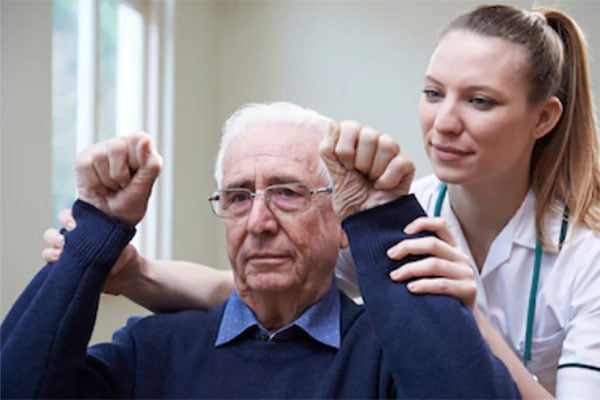As with many acute medical situations, early identification and intervention of stroke symptoms are key.

A stroke, also called a cerebrovascular accident (CVA), is the fifth leading cause of death and disability in the United States according to the American Stroke Association. Strokes are caused by a disturbance of oxygen and blood flow to the brain which results in the death of brain cells that can cause difficulties with various bodily functions.
There are three types of strokes: ischemic, hemorrhagic and a transient ischemic attack (TIA).
Recommended course: Stroke Rehabilitation Maximizing Outcomes: Interventions
Ischemic strokes
Ischemic strokes are caused by a blood clot that disrupts blood flow to the brain. These account for over 80% of all strokes as reported by the National Heart, Lung and Blood Institute.
The primary cause of ischemic strokes is fatty deposits (also called plaques) built up in the arteries. This causes a narrowing of the vessels (stenosis) over time and can result in blockages. Medical conditions such as hypertension (high blood pressure), diabetes, and other heart and vascular diseases are major risk factors for an ischemic stroke.
Published in 2021 the journal Stroke by the American Heart Association, emerging evidence that lends support to a correlation between ischemic stroke among people who have had COVID-19.
Hemorrhagic strokes
Hemorrhagic strokes, which are less common, are caused by a ruptured blood vessel which triggers bleeding within the brain. There is limited space to absorb the additional fluid within the skull, which can create an abnormal buildup of pressure within the brain.
A congenital malformation in the brain vasculature, called arteriovenous malformation, can cause hemorrhagic strokes. Brain aneurysms, which occur when a weakened part of the blood vessel wall ruptures or bleeds, are another cause.
Transient ischemic attack
A transient ischemic attack (TIA), also known as a ‘mini-stroke,’ is a temporary blockage of oxygen and blood flow to the brain. Usually due to a clot, which can dissolve or get dislodged on its own, the symptoms of a TIA are temporary and usually resolve within 24 hours.
However, the symptoms of a TIA can mirror an actual stroke. In fact, a person that has a TIA is at risk of having an actual stroke per reports by the American Heart Association. Causes of TIA can be a clot or blockage in a small blood vessel in the brain, called a lacunar stroke. High blood pressure, diabetes, smoking, atrial fibrillation, heart attack, or a prior history of a stroke or TIA are all risk factors.
Because the obstruction of blood flow and oxygen to the brain is temporary with a TIA, there are usually no lasting disabilities. However, it should serve as a warning to address controllable risk factors to prevent/reduce future occurrences.
Recommended course: Clinical Effects and Considerations of Stroke Based on the Affected Region of the Brai
Stroke symptoms
Symptoms of a stroke or TIA can be wide-ranging and include:
- Muscle weakness and paralysis, usually on one side of the body
- Facial asymmetry such as an eyelid or lip droop
- Difficulty moving or detecting sensation in the arms and legs
- Cognitive problems such as disorientation and confusion
- Communication difficulties including speaking and interpreting language
- Problems with vision, including double vision or difficulty seeing
- Dizziness or loss of balance
- Behavioral changes including lack of safety and judgment
F.A.S.T.
As with many acute medical situations, early identification and intervention are key. Public health entities such as the American Stroke Association and the American Heart Association have endorsed acronyms such as FAST to communicate an easy-to-remember phrase regarding common symptoms of stroke/TIA to promote early recognition and treatment.
- Facial weakness: Can the person smile? Has their mouth or eye drooped? Any unevenness?
- Arm weakness: Can the person raise both arms? Is one arm weak or numb?
- Speech problems: Can the person speak clearly? Can they understand what is said to them?
- Time to call: If you see any of these above signs, call 911 or your local emergency dispatch. Be sure to note the time of the onset of symptoms, as this can impact future medical interventions. For example, if medical imaging determines that the stroke is ischemic, and the timing of the onset of the symptoms is known and within a particular range, the person might be a candidate to receive a clot-busting medication which can cause the clot to dissolve. This may minimize brain damage and future complications.
Risk factors for strokes
Although some risk factors of stroke are out of a patient’s control (such as age, gender, ethnicity and congenital conditions), there are controllable risk factors for strokes. Smoking, drugs, obesity, high cholesterol, and uncontrolled hypertension due to poor diet and nutrition are all major factors within a patient’s control.
Stroke assessments
There are several assessments rehabilitation professionals can use to evaluate stroke symptoms. These include the National Institute of Health Stroke Scale and the American Heart Association Stroke Outcome Classification.
Common post-stroke communication challenges for clients can include aphasia, dysarthria, apraxia, cognitive deficits and reading and writing difficulties. Occupational therapy practitioners can use evidence-based interventions to address post-stroke communication challenges. Additionally, they may engage in interprofessional collaborative practice with speech-language pathology professionals.
Here are some helpful tips for communicating with a person experiencing communication difficulties post-stroke.
- Normalize the environment, including reducing background noise to eliminate distractions
- Keep commands simple and questions close-ended
- Exercise patience by speaking slowly and at a normal volume
- Pause frequently to allow the person to process the information
- Encourage the use of common gestures or other communication methods such as pen/paper (writing), visual aids or apps.
To stay informed about best practice and evidenced-based guidelines, occupational therapy practitioners should seek out and utilize resources promoted by the American Occupational Therapy Association (AOTA) regarding stroke care, including AOTA’s OT Practice Guidelines for Adults with Stroke.
____________________________________________________________________________________________
This article was written by Elizabeth D. DeIuliis, OTD, MOT, OTR/L, FNAP.

 Call
Call
Leave a Reply